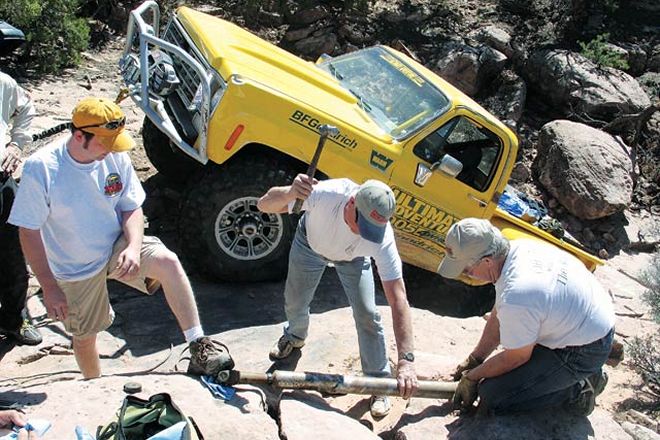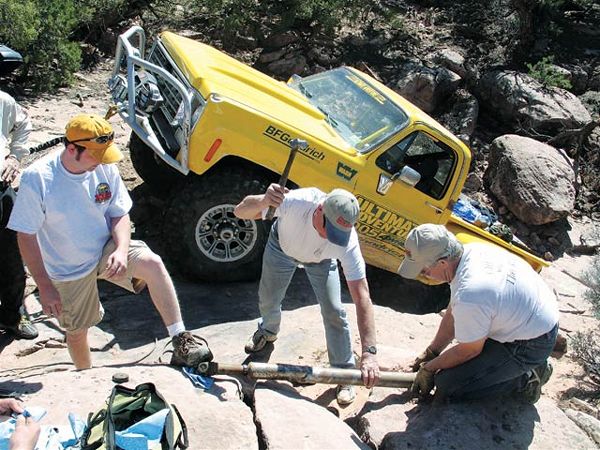

Wheeling is not without risks, and the harder we push it, the more risks we take. Trail breakage is the most common problem we face in the field, but if you know how to fix the carnage then you can keepwheeling and not waste the day on the side of the trail. Naturally, you should carry any common spare parts that might disrupt your trail ride, as well as the critical chemicals to make things right. Proper tools and the knowledge to use them are just as important, as well as specialty stuff like a Hi-Lift Jack and a snatch strap. But most important is the ingenuity of using what you and your trail buds have to make that special fix that steps outside the bounds of what you brought along.
Our recent trip to Moab had us driving the 2005 Ultimate Adventure Chevy on the Green Day trail out at Area BFE. As with almost any trip we loaded up most of our critical trail tools and supplies and set out with a small group to open a new section of trail. Halfway through the trail we came to a 4-foot ledge with a notch in the center, just right for clearing our low-hanging rear driveshaft as we climbed the cliff. Unfortunately, we were 1 inch off to the right, and our driveshaft hit the rock and dented, resulting in a sausage-looking twist to the tube that luckily stayed together but hindered further trail time.
This wasn't our first driveshaft breakage--nor will it be the last--but we sure didn't have a spare, and the big oddball size and length meant no one else did either. We could have left the truck, walked the 20 miles back to town with the shaft and have a shop retube it, but what fun would that be? We decided to do what we like best, a trail fix with what resources we had, which was next to nothing. The only way to save the shaft was to weld it together with some bracing. We had two batteries and plenty of welding rod so we could weld it. Jumper cables would be welding leads, and we had all the tools to remove the shaft, but what about steel to brace it? We had little on board, but the front bumper could be hacksawed apart if needed.
As luck would have it, Pat Gremillion of Premier Power Welder and Pull-Pal was a few vehicles ahead of us. The call had gone out on the CB for scrap steel for our predicament, without so much as a call back about old well pipe, fence posts, scrap exhaust tubes, or the like. Ready to hacksaw off our front bumper for material, Pat came happily dancing down the trail with the shovel end of his Pull-Pal trail anchor, which happens to be made of 4130 chromoly heat-treated steel, and would easily strengthen the driveshaft for further use. While not the cheapest fix (like welding our junk wrenches together for a scab patch), the plate was the steel we needed. Pat broke out his onboard Premier Power Welder on his Bronco to merrily slice and dice the Pull-Pal plate, then weld our driveshaft back together with it. Ingenuity is what it took for this trail fix, and Pat and his crew jumped in and had us back wheeling before we could break out the jumper cables. Check out the photos for details of what went right.








